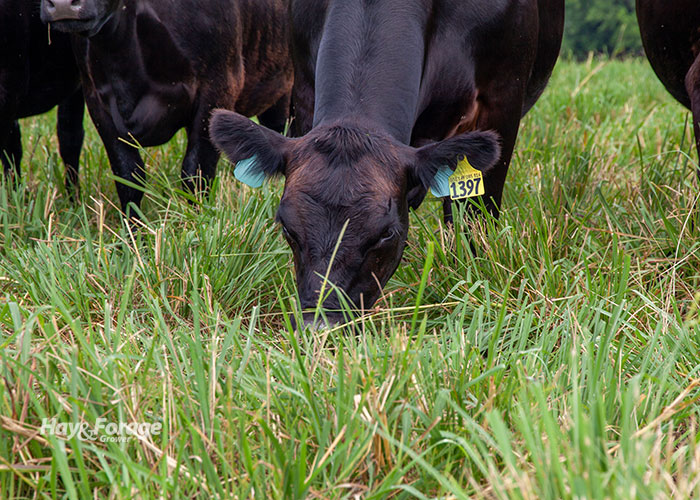
Many states lit up the U.S. Drought Monitor in some shade of yellow, orange, or red this past year, especially in parts of the Midwest, the High Plains, and the South. Despite some relief from late season rains, the lasting effects of this dry spell may be depicted by damaged pastures and echo off the walls of empty hay barns.
In some regions, dedicating a portion of land to native warm-season grasses can afford farmers more flexibility in feeding livestock. These drought-tolerant species can be an asset for hay production and grazing rotations when cool-season forages go dormant in the summer; however, many farmers may question if native warm-season grasses fit in their operation.
At the Missouri Livestock Symposium held earlier this month in Kirksville, Mo., Jamie Kurtz shared insight he has gained from growing native warm-season grasses on his farm. Species like switchgrass, indiangrass, and big bluestem comprise about 50 of the 215 total grazing acres on his cow-calf operation near West Plains, Mo., that he runs with his father.
Kurtz, the state grasslands specialist with the Natural Resources Conservation Service, views native warm-season grasses as tools to mitigate the negative effects drought can have on forage production, and thus livestock performance. Speaking from personal and professional experience, he debunked — and confirmed — some of the myths surrounding these species.
Myth 1 – Limited stand longevity
The first myth Kurtz addressed was that native warm-season grasses are not persistent. He explained stand longevity for native grass pastures is largely dependent on grazing practices, and like most other forages, repeated overgrazing will restrict plant persistence.
Grazing too late in the season can weaken a native grass system, too. Kurtz said he received several phone calls from producers last summer about grazing native warm-season grasses into the fall since dry conditions curbed cool-season grass growth. Even though this could have reduced the drought-induced forage shortage, it would not be worth it in the long run.
“Everything that you’re going to take off in the fall, you’re going to lose next spring,” Kurtz stated. He also mentioned forage quality quickly declines when native warm-season grasses go dormant, so animals would not be able to meet their nutritional needs.
Myth 2 – Slow establishment
Lost production during establishment is another concern producers can have regarding native warm-season grasses. Instead of busting this myth, Kurtz confirmed it. Species like switchgrass, indiangrass, little bluestem, and big bluestem are slow to establish, so it is critical to have other forages available for livestock.
“I’m not going to sugar coat it and tell you we are going to have tons of production in the first year, because we’re not,” Kurtz asserted. He recommended planting annual warm-season forages, such as sorghum species, for summer grazing or hay production in the establishment year.
Myth 3 — Unsuccessful seedings
To elaborate on the previous myth, Kurtz shared that some producers are skeptical of native warm-season grass establishment in general. After experiencing several cases of unsuccessful seedings, he argued that site preparation is the most important step of establishment, especially when it comes to controlling competition.
“We’ve got to make sure we get all of the fescue and annual weeds out of the way,” Kurtz said. “Spray everything with herbicide, plant an interim crop in the spring or fall, and then use a preplant herbicide.”
A firm seedbed is also key for good establishment, which Kurtz said looks like a footprint in the soil that is no more than a quarter-inch deep. He also advised using a shallow seeding depth for native warm-season grasses. If no-tilling seed, make sure 25% to 50% of seeds are visible on the soil surface.
Myth 4 – Diversity over monocultures
A diverse forage stand can have several benefits, both agronomic and environmental. When it comes to native warm-season grasses, though, Kurtz said a monoculture will likely be easier to establish and maintain compared to a combination of species.
“Monocultures are a little easier to manage, while diverse stands can be kind of tricky,” Kurtz said. “I’m not discouraging diverse stands; I’m just saying they can be tough. If I’d never dealt with native warm-season forages, I would not start with a diverse stand.”
With that said, Kurtz recommended incorporating a legume component into established native warm-season grasses to boost forage quality and provide nitrogen to the stand. He overseeds annual lespedeza into the native species on his farm in southern Missouri about every five years, but suggested seeding birdsfoot trefoil in more northern regions of the Show-Me State.
Myth 5 – Poor forage quality
The final myth Kurtz presented was that native warm-season grasses have poor forage quality. After conducting his own forage and livestock fecal samples, he found species like big bluestem, indiangrass, and switchgrass had sufficient crude protein and energy levels to sustain cows through the summer with mineral supplementation. These species can also be harvested for high-quality hay.
For example, Kurtz’s analysis showed his big bluestem forage had 13% crude protein (CP) and 70% digestible organic matter (DOM), which he said translates to a projected average daily gain of 2.9 pounds per day. His indiangrass also had roughly 13% CP and had 70% DOM at the time of sampling in late July.
When Kurtz sampled his switchgrass, it had 16% CP and 67% DOM; however, these values represented forage quality in late May when cool-season grasses were still productive. He noted that switchgrass matures relatively early in the growing season, so it can be challenging to take advantage of both types of forage in a short period of time.
Regardless of the forage species, switching animals from cool-season grasses to native warm-season grasses, and vice versa, should not be an immediate transition. Not only do cattle need to get used to the difference in palatability, but they must adjust also to the effects a new feedstuff can have on rumen activity.

